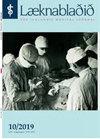[Gastrointestinal symptoms and dietary intake of patients with irritable bowel syndrome following a low FODMAP diet].
IF 0.6
4区 医学
Q3 MEDICINE, GENERAL & INTERNAL
引用次数: 0
Abstract
INTRODUCTION High FODMAP (fermentable oligo-, di, monosaccharides and polyols) foods have been linked with worsening symptoms of IBS patients. The aim was to compare gastrointestinal symptoms and dietary intake of patients with irritable bowel syndrome following a low FODMAP diet, with or without individual nutrition therapy. MATERIALS AND METHODS A total of 54 patients that met Rome IV criteria for IBS were randomized into two groups, guided group (individual nutrition therapy, n=28) and self-management group (learned about low FODMAP diet online, n=26). Both groups followed low FODMAP diet for 4 weeks. Four-day food records were used to assess dietary intake. Symptoms were assessed by the IBS-severity scoring system (ISB-SSS). RESULTS The number of subjects who did not complete the study was 13, thereof five in the nutrition therapy and eight in the self-management group, leaving 23 and 18 subjects available for analysis, respectively. Symptoms declined from baseline to endpoint in both groups, by 183±101 points on average in the group receiving nutrition therapy (p< 0.001) and 132±110 points in the self-management group (p< 0.001), with no difference between groups. At baseline, about 80% of meals in both groups contained food high in FODMAP's. The corresponding proportion was 9% and 36% in week 3 in the nutrition therapy and self-management group, respectively (p< 0.001). CONCLUSION Both groups experienced relieve of symptoms, but compliance to the low FODMAP diet was better in the group receiving individual nutrition therapy compared with the group who only received instructions on how to learn about low FODMAP diet online.[肠易激综合征患者采用低 FODMAP 饮食后的胃肠道症状和饮食摄入量]。
简介高 FODMAP(可发酵低聚糖、双糖、单糖和多元醇)食物与肠易激综合征患者症状的恶化有关。材料和方法将符合罗马IV标准的54名肠易激综合征患者随机分为两组,即指导组(个体营养治疗,28人)和自我管理组(在网上了解低FODMAP饮食,26人)。两组均遵循低 FODMAP 饮食 4 周。采用四天食物记录来评估饮食摄入量。结果未完成研究的受试者人数为13人,其中营养治疗组5人,自我管理组8人,可供分析的受试者人数分别为23人和18人。从基线到终点,两组受试者的症状均有所减轻,营养治疗组平均减轻了183±101分(P< 0.001),自我管理组平均减轻了132±110分(P< 0.001),组间无差异。基线时,两组中约有 80% 的膳食中含有高 FODMAP 食物。结论两组患者的症状均有所缓解,但与仅接受如何在线了解低 FODMAP 饮食指导的组别相比,接受个体营养治疗的组别对低 FODMAP 饮食的依从性更好。
本文章由计算机程序翻译,如有差异,请以英文原文为准。
求助全文
约1分钟内获得全文
求助全文
来源期刊

Laeknabladid
MEDICINE, GENERAL & INTERNAL-
CiteScore
0.50
自引率
25.00%
发文量
63
审稿时长
>12 weeks
期刊介绍:
Læknablaðið er fræðirit sem birtir vísinda og yfirlitsgreinar og annað efni sem byggir á rannsóknum innan læknisfræði eða skyldra greina. Læknablaðið er gefið út af Læknafélagi Íslands. Blaðið er sent til allra félagsmanna. Það var fyrst gefið út árið 1904 en hefur komið samfellt út frá árinu 1915. Blaðið kemur út 11 sinnum á ári og er prentað í 2000 eintökum. Allt efni Læknablaðsins frá árinu 2000 er aðgengilegt á heimasíðu blaðsins á laeknabladid.is og er aðgangur endurgjaldslaus og öllum opinn.
 求助内容:
求助内容: 应助结果提醒方式:
应助结果提醒方式:


